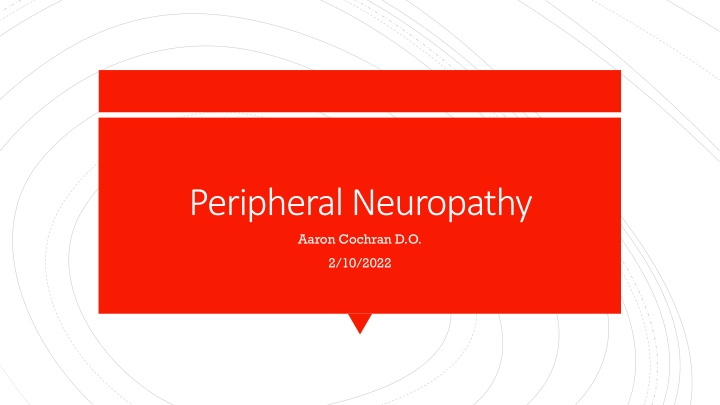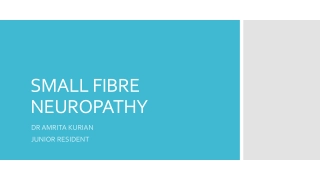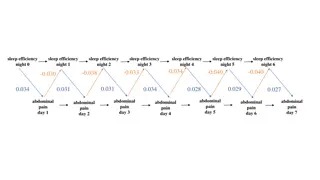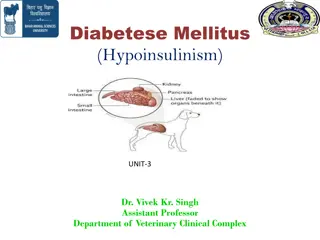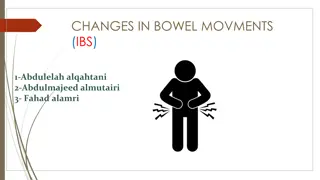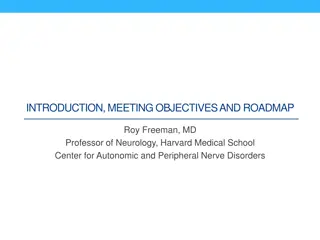Neuropathy: Symptoms, Patterns & Etiology
Neuropathy, affecting millions worldwide, presents with varied symptoms and patterns. Learn about its prevalence, nerve fiber types, and patterns to better understand this condition's complexity.
Download Presentation

Please find below an Image/Link to download the presentation.
The content on the website is provided AS IS for your information and personal use only. It may not be sold, licensed, or shared on other websites without obtaining consent from the author.If you encounter any issues during the download, it is possible that the publisher has removed the file from their server.
You are allowed to download the files provided on this website for personal or commercial use, subject to the condition that they are used lawfully. All files are the property of their respective owners.
The content on the website is provided AS IS for your information and personal use only. It may not be sold, licensed, or shared on other websites without obtaining consent from the author.
E N D
Presentation Transcript
Peripheral Neuropathy Aaron Cochran D.O. 2/10/2022
Prevalence is 2400 per 10000 people midlife and >8% of patients over 55 years old. Diabetic neuropathy is the most common neuropathy in the world. Epidemiology For 25-30% of patients the etiology of the neuropathy is unknown.
Nerve fiber types
Large fibers (Type 1, 2) myelinated nerves that conduct impulses fast. Tested on exam by light touch, vibration, proprioception Nerve fiber types Small fibers (Type 3, 4) thinly myelinated or unmyelinated fibers that conduct impulses slower. Tested on exam with pain and temperature sensation.
Where are the symptoms located? (Is it a distal symmetric neuropathy with numbness burning and tingling in the feet or is it asymmetric and patchy affecting random nerves?) What is the pattern of the Neuropathy? Some neuropathies are length dependent (starting in the feet and progressing to the knees and then affecting the hands) Other neuropathies are non-length dependent (will heavily affect the upper extremities and mildly affect the lower extremities
Has this been a slow and steady process that is mildly worsening over years (more common in an axonal neuropathy) (Diabetes, alcoholism) What is the time course of the symptoms? Has it been a subacute process (over weeks to months progressive) May be an autoimmune neuropathy (CIDP, Sjogrens, Lupus, RA) Has this been a acute rapidly progressive process over hours to days suspicious for acute autoimmune neuropathy (Guillen Barre Syndrome)
Neuropathy Patterns
Positive Symptoms Inappropriate spontaneous nerve activity (fasciculations, myokymia, cramps) Burning/lancinating pain Tingling or paresthesias Allodynia Hyperalgesia Symptoms
Negative Weakness Fatigue Muscle atrophy or wasting Hypesthesia Symptoms Autonomic Early satiety Bloating Constipation/diarrhea Impotence Hyperhidrosis, orthostasis Urinary Incontinence Skin color changes
Thorough history: Onset: Acute vs. chronic Progression: Monophasic, Slowly progressive, rapid, step wise or relapsing remitting Location: Distal (stocking glove pattern), proximal and distal Sensory vs. motor vs. sensorimotor Symmetrical or asymmetrical pattern? Medical history, risk factors DM Nutritional deficiencies (Post bariatric surgery) Systemic illness (CKD, liver disease, connective tissue disorders, infections, bariatric surgery, cancer, infections s/ Hep C, HIV) Drugs (statins, antibiotics, chemotherapy, HIV medications) Toxins (alcohol, drugs, occupational toxic exposures) Family history Smoking (paraneoplastic) Evaluation and Exam is key!
General exam: Rash (vasculitis), hyperpigmentation (POEMS), oral ulcers (Behcet s), Salivary gland swelling, dry eyes and mouth (Sjogren s), Gum lines (lead), mee s lines (arsenic or thallium) Chronic changes: Dystrophic skin changes, hammer toes, high arches (hereditary), kyphoscoliosis. Nerve hypertrophy (leprosy and HNPP) Examination Cranial nerve exam Exam: Sensory vs. sensorimotor vs. motor Sensory exam (Fiber type: large vs. small) (pain and temperature affected = small fiber, vibration and proprioception affected= large fiber) Autonomic dysfunction Reflexes (should be decreased in peripheral neuropathies)
Routine labs: CBC, CMP, 2 hour GTT, Hemoglobin A1c, ESR, TSH, B12, serum Immunofixation, B1, B6, B3, Vitamin E, SPEP, Kappa/Lambda Light chains, RF, ANA, ANCA profile, SSA, SSB, DSDNA, UPEP is a good initial screen Ask about potential toxic exposures, history of alcoholism Electrodiagnostic testing EMG/NCS Axonal vs. demyelinating Sensory vs. motor Symmetric Focal abnormalities vs. generalized abnormalities Plexopathy, Radiculoplexusneuropathy, mononeuritis multiplex (multifocal polyneuropathy) Workup/Testing
Axonal (will have low amplitude responses with mildly abnormal to normal latencies and mildly decreased conduction velocities) the guts of the nerve are affected Demyelinating (will have significantly prolonged latencies and significantly slower conduction velocities, may have conduction block and temporal dispersion) The outer sheath of the nerve is affected. Axonal vs Demyelinating on EMG/NCS If Demyelinating neuropathy: check Anti- MAG, Anti-SGPG, Anti-GD1b, Antisulfatide antibodies, Anti GM1, Anti-GQ1b, Anti- GD1a (variants of GBS), Neurofascin antibodies (NF 140 and NF 155), Contactin- 1 antibodies (Neurofascin and Contactin-1 antibodies are associated with CIDP).
Painful, Asymmetrical, asynchronous sensory and motor peripheral neuropathy involving simultaneous, or sequential damage of two or more noncontiguous peripheral nerves. (ulnar nerve lesion in left arm followed by a peroneal nerve lesion in the right leg) Stepwise progression over days to weeks Can be seen in Diabetes Mellitus, Vasculitis (usually axonal pattern and painful), Inflammatory demyelinating peripheral neuropathy (MADSAM) (usually painless and demyelinating), Multiple entrapments (acquired vs. hereditary HNPP), infection, Neoplastic, Cryoglobinemia. Churg Strauss, HIV, RA, Sarcoidosis, Wegeners granulomatosis, Leprosy, periarteritis nodosum, Lupus, Waldenstroms macroglobulinemia. Mononeuritis Multiplex Serious Illness, needs Rheumatology consult, appropriate labs, nerve biopsy and possibly hospitalization
Must rule out Vasculitis if Mononeuritis Multiplex pattern and patients symptoms progressing!!! Check CRP, ANA, ESR, DSDNA, SSA, SSB, RF, Hep B, Hep C, C-ANCA, P-ANCA, Cryoglobulin, ACE. Suspected Vasculitis Will need to check nerve biopsy if suspected vasculitis. Biopsy a nerve that is involved. Do not biopsy a nerve that is normal as it will damage the nerve. Use EMG/NCS study and clinical exam to identify involved nerve. (sural sensory, superficial peroneal sensory nerve, superficial radial sensory nerve all commonly biopsied.)
More than 100 genetic defects isolated. AD, AR, X linked, Hereditary Neuropathies CMT (HMSN) Hereditary motor neuropathies, Hereditary sensory and autonomic neuropathies
HMSN (CMT) 1A- Autosomal dominant PMP 22 duplication on chromosome 17 Nerve conduction studies show demyelination (diffuse slowing of the conduction velocities (15-25 m/s), prolonged distal latencies. Clinically patient will have sensory and motor symptoms, length dependent, with distal atrophy and champagne bottle legs , areflexia , hammer toes, high arches Hereditary Neuropathies Biopsy shows onion bulbs due to repeated remyelination attempts No feature of acquired/autoimmune demyelination (No conduction block or temporal dispersion)
Family history of neuropathy Lack of positive symptoms (no significant neuropathic pain typically) Early age of onset Symmetric findings Kyphoscoliosis, shortening of the Achilles tendon, hammer toes Very slow progressive course. Need genetic testing/counseling CMT
CMT 1 b : Myelin Protein Zero HMSN 2 (CMT 2) Axonal (low amplitude and mildly decreased conduction velocities, Autosomal dominant) HMSN 3: Dejerine Sottas disease: infantile onset of severe demyelinating neuropathy with conduction velocities less than 10 m/s. CMT CMT X: X linked recessive, Connexin 32 (mixed) Genetic panels for CMT available for patients with high suspicion. Nerve biopsy typically not needed in classic cases. Still many idiopathic cases. Genetic panel identifies 30- 40%.
Hereditary Neuropathy with Liability to pressure Palsy PMP22 Deletion, Chromosome 22 Recurrent, painless, focal mononeuropathies at the common sites of compression (median nerve at the wrist, ulnar nerve at the elbow, peroneal nerve at the fibular head), with minor compression or trauma. Not painful and not an axonal pattern (unlike vasculitis/mononeuropathy multiplex) HNPP Onset Usually in 2-3rddecade Recovery in days to weeks. (mononeuritis multiplex/Vasculitis would not recover without treatment) Chronically, may develop distal sensorimotor symptoms, absent ankle reflexes. NCS: Prolonged latencies out of proportion to conduction velocities, and focal conduction slowing at common sites of entrapment
Nerve Biopsy in HNPP Focal areas of myelin thickening due to myelin re- duplication on teased fiber preparation.
Autosomal Dominant ?Ch 17 (some families) SEPT-9 gene Clinically present as recurrent attacks of painful brachial plexopathy, onset 1-3rd decade. Hereditary Brachial Plexopathy Acute severe pain followed by weakness in a patchy distribution in the affected arm with some minor sensory involvement at times. Patchy involvement, C5-6 commonly involved May be a presentation of HNPP. If this is the case it is usually painless Indistinguishable from Parsonage turner syndrome Neuralgic Amyotrophy
AIDP (Guillen Barre Syndrome): Classically acute to subacte presentation with ascending sensorimotor symptoms. Proximal and distal weakness. Diminished/Loss of reflexes. Preceded by illness (respiratory vs. diarrhea), surgery, postpartum, vaccinations CN involvement: facial nerve. Extra ocular movements (Miller-fisher variant) Gq1b antibody Autonomic involvement. Nadir in 2-4 weeks AIDP CSF: Albumino-cytologic dissociation (may be normal within the first week) NCS s: Acquired Demyelinating features, conduction block, temporal dispersion, prolonged F-waves, absent H reflex, sural sparing may occur. May take up to 5 days to see full nerve conduction changes. First abnormality is H reflex then F waves. (However if those are the only abnormalities it is a nonspecific finding.) 5% mortality due to autonomic symptoms
Temporal dispersion and conduction block
Close monitoring in ICU, supportive care Monitoring of respiratory parameters FVC, MIP, NIF and Vital capacity need monitored. Management of AIDP (Guillen Barre Syndrome) Cardiovascular stability, telemetry to monitor for arrhythmias. IVIG or PLEX: equally beneficial No data to support corticosteroids
AMAN: Acute motor axonal neuropathy C jejuni GM1, GM1b, GD1a antibodies Nerve conduction will show motor nerves affected and sensory nerves spared AMSAN: Acute Motor and Sensory Axonal Neuropathy C jejuni Motor and sensory nerve affected on nerve conduction AIDP variants Miller Fisher Variant Ataxia, ophthalmoplegia and areflexia GQ1b antibodies, GD1b antibodies Favorable prognosis but may evolve into typical GBS Most patients treated with IVIG
Insidious onset, slow and gradual progression (although rarely can present as AIDP and then progression continues past 8 weeks = Acute CIDP) Weakness, proximal and distal Sensory loss, large >small fiber (more numbness, loss of vibration, proprioception, ataxia, weakness). Sensory ataxia Reflexes reduced to absent CIDP NCS: Demyelinating neuropathy, with conduction block and temporal dispersion CSF, elevated protein, normal cells Check Immunofixation, SPEP, Kappa/Lambda light chains, UPEP, Neurofascin antibodies, Contactin 1 antibodies Treatment: Corticosteroids, IVIG/PLEX first line. Steroid sparing agents and other immunosuppresants 2ndline.
MMN, multifocal motor neuropathy Asymmetric, painless weakness Most commonly involved UE s GM1 antibodies detected in 50% No sensory symptoms, no UMN signs Slowly progressive over months to years. Decreased reflexes in the distribution of the affected nerves. CSF protein usually normal Treatment: IVIG, cyclophosphamide Multifocal Motor Neuropathy vs. MADSAM MADSAM: aka Lewis-Sumner variant or multifocal CIDP Asymmetric, distal >prox, Onset in UE>LE s NCS s: pattern of multiple mononeuropathies and focal or multifocal conduction block Sensory nerves involved CSF protein may be elevated. Treatment: IVIG
MGUS serum monoclonal protein <30g/L, <10% plasma cells in the bone marrow, no constitutional symptoms or end organ damage IgM most common, 50% of these IgM-MGUS have anti-MAG antibodies Paraprotein associated neuropathies Clinically, distal sensory >> motor demyelinating neuropathy (DADS) Very slowly progressive, don t respond well to immunotherapy Other antibodies: Anti-sulfatide, Anti-SGPG IgG/A MGUS, not as common as IgM, behave like CIDP, respond well to treatment
Chronic sensorimotor demyelinating peripheral neuropathy IGM monoclonal gammopathy with MGUS or nonhodgekins lymphoma, waldenstroms macroglobulinemia MAG antibody positive Neuropathy Should be evaluated by heme/onc at diagnosis Typically distal sensory loss in feet with sensory ataxia. May eventually have distal motor weakness. Rituximab helps 50%. IVIG may be tried early on for incomplete benefit, Steroids, Steroid sparing agents typically don t help.
Gait disorder Autoantibody to a neural antigen Late age at onset Polyneuropathy of mild to moderate severity GALOP Syndrome Associated with high titers of anti-sulfatide antibodies, Titers more than 1: 10,000 specific for chronic, demyelinating sensory>motor neuropathy
Demyelinating or axonal Age >50 Gait disorder Chronic slowly progressive, sensory > motor, painful neuropathy Anti-Sulfatide Antibodies Serum IgM paraprotein. Treatment : IVIG, Cytoxan Steroids are not useful.
Polyneuropathy, Organomegaly, Endocrinopathy, Monoclonal gammopathy, Skin Changes Rule out Osteosclerotic myeloma. Check Skeletal survey Mostly IgG, less commonly IgA Lambda light chain POEMS Vascular Endothelial growth Factor levels (VEGF) are elevated. May have thrombocytosis Length dependent painful neuropathy 33% wheelchair bound at onset
TS-HDS antibody- Patients will have sensory axon loss with IGM deposits around medium sized vessels and capillaries with complement deposits Painful sensory more than motor large fiber neuropathy with hand discomfort TS-HDS and FGFR3 neuropathy May cause painful small fiber neuropathy as well FGFR3 antibody- associated with sensory large fiber neuropathy and sensory neuronopathy. Distal leg paresthesia, foot drop, and unsteady gait IVIG response in some. Currently clinical trials ongoing.
Most common Chronic Slowly progressive Axonal Peripheral Neuropathy DM: most common etiology Vast differential, systemic diseases like liver or kidney disease, nutritional, endocrine, autoimmune, toxic (drugs), idiopathic, age related.
Generalized axonal neuropathy Large, small or autonomic fiber involvement 70% of patients with diabetes will have mild to moderate neuropathy after 15 years Compressive focal neuropathies Diabetic Neuropathy Diabetic amyotrophy (Radiculoplexusneuropathy) Cranial neuropathies Mononeuritis multiplex Diabetic truncal radiculoneuropathy Insulin Neuritis
Treatment induced neuropathy of diabetes:Insulin Neuritis . Secondary to an abrupt improvement in glucose control. Hemoglobin A1c will improve by 2 points over a three month period. Presents with burning and severe neuropathic pain roughly 6 weeks after improvement in glucose. Insulin Neuritis Autonomic dysfunction will be present as well. Pain should improve within 12 to 24 months. Will need neuropathic pain medications
Diabetic Lumbosacral Radiculoplexus Neuropathy (DLRPN) Typical presentation is acute severe pain in lower back, hip or thigh, followed by proximal weakness in affected extremity. May progress to distal weakness in that extremity. Can spread from one leg to another and then to an arms. Diabetic Amyotrophy Secondary to a microvasculitis. Monophasic. No proven treatment. However if patient is actively declining and has active disease on EMG study can consider Solumedrol, IVIG or Plasmapheresis. Treatments meant to halt progression of disease and allow recovery to occur.
Patients need aggressive physical therapy. Workup includes MRI lumbar spine with contrast, MRI thigh with contrast to rule out lumbar plexus abnormality, EMG/NCS, LP may show elevated protein. Check CSF Cytology to rule out malignancy. Check serum vasculitis labs. Diabetic Amyotrophy Nerve biopsy typically not needed if history is classic.
B6 deficiency can both lead to peripheral neuropathy Absorbed in the upper GI, excreted By kidneys Inflammatory bowel disease and intestinal surgery can lead to malabsorption Vitamin B6 deficiency 15-20% of bariatric surgery patients get B6 deficiency Dialysis can lower B6 levels Carbidopa/Levodopa, isoniazid, hydralazine, and phenylzine can all lower B6 level Axonal, acute severe painful, primary sensory neuropathy
Can lead to a pure sensory axonal neuropathy Do not recommend take more than 50-100 mg B6 supplement a day. Vitamin B6 Toxicity Monitor fasting blood levels if on supplement. No supplement should be taken 24 hrs prior to B6 level being drawn Not concerning until serum B6 level greater than 100.
Vegetarians are at risk. Atrophic gastritis, bariatric surgery can reduce intrinsic factor production and lead to decreased B12 level. Chrones, Celiac Disease can decrease absorption of B12 at the terminal ileum. Dairy, eggs, seafood, poultry, meat, fortified cereals have B12. Vitamin B12 Deficiency PPI s, H2 blockers decrease B12 absorption, Metformin lowers B12 levels. Nitrous Oxide Huffing decreased B12 levels and leads to acute/subacute painful sensory ataxic neuropathy Pernicious Anemia- antibodies against Intrinsic factor. Check parietal cell antibodies.
Can lead to large fiber sensory loss, lateral corticospinal tract and dorsal column dysfunction on the spinal cord subacute combined degeneration May lead to spasticity, posterior column dysfunction (decreased vibration sense and proprioception), autonomic dysfunction, bladder dysfunction, optic neuropathy, memory and mood disorders Vitamin B12 Deficiency MRI may show cord changes posteriorly. Check B12 level, MMA, Homocysteine level (last two will be elevated in true B12 deficiency). May have megaloblastic anemia. Treatment may prevent progression but may not reverse all symptoms.
Usually sensorimotor peripheral neuropathy Alcoholics without B1 deficiency seem to have small fiber peripheral neuropathy Alcohol induced Polyneuropathy Alcoholics with B1 deficiency have large fiber peripheral neuropathy. Stopping alcohol may prevent progression.
AL amyloidosis (light chain) Amyloid wild type (ATTR wt) Protein misfolds but there is no substituted amino acid Hereditary Amyloidosis- ATTR mutation-single amino acid substitution Amyloidosis Familial Amyloid polyneuropathy Familial Amyloid cardiomyopathy Sporadic mutations can occur and there will not always be a postitive family history.
Mutations in V1221, 168L, L111M, T60A are cardiac phenotypes Insoluble protein fibers, conformational changes into beta pleated sheets, apple green birefringence on congo red stain. High risk for left atrial thrombus and embolic stroke. Amyloidosis EKG may show low voltage, BNP will be elevated. Echo may have LVH, RVH, thick mitral valve, tricuspid valve, thick interatrial septum, biatrial enlargement. Cardiac MRI may show global transmural or subendocardial delayed gadolinium enhancement. Endomyocardial biopsy will be positive 95% of the time if patient has amyloid.
Mutations in V30M, F33L, C10R are neurological phenotypes Acute/subacute rapidly progressive neuropathy. May begin in upper extremities. Cardiomyopathy, carpal tunnel syndrome, peripheral neuropathy. Amyloidosis Orthostatic hypotension, diarrhea, constipation, erectrile dysfunction (autonomic symptoms) May be misdiagnosed as CIDP initially but will not be responsive to treatments.
Nuclear Scintigraphy- can diagnose ATTR amyloidosis after a plasma cell disorder has been ruled out. Tracer will be taken up by cardiac muscle with amyloidosis. Grade 2 or 3 is confirmatory for ATTR but will not tell you if it is wild type or a mutation. Abdominal fat pad biopsy: Minimal risk, AL amyloid 60- 80%. ATTR 40%, Wild type less than 25% will be found if they have the diagnosis with AFPB. Amyloidosis Amyloid positive area should be dissected out and sent for mass spectroscopy to tell if it is AL amyloid, ATTR, or TTR wild type. Skin Biopsy: If peripheral neuropathy symptoms.
Check Kappa/Lambda light chains, SPEP, UPEP, Immunofixation If abnormal get Hematology referral. Consider biopsy of affected organ (cardiac or renal) or abdominal fat pad Amylodiosis If fat pad biopsy negative then affected organ should be biopsied.
